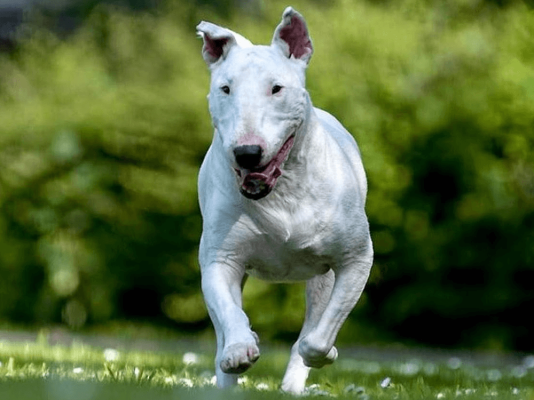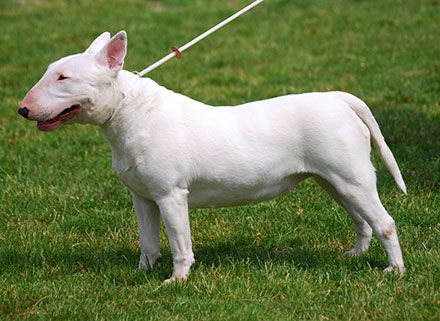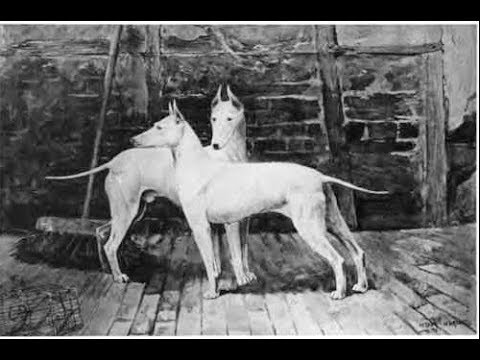White English Terriers, often simply called "English Terriers," are a charming and spirited breed known for their distinctive white coats and lively personalities. In this comprehensive guide, we will explore the fascinating world of White English Terriers, covering their history, physical characteristics, temperament, health considerations, training needs, grooming requirements, and much more. Whether you are considering bringing one of these delightful dogs into your home or simply interested in learning more about them, this article will provide you with valuable insights into this beloved breed.

History of the White English Terrier
The history of White English Terriers can be traced back to the early 19th century in England. These dogs were originally bred for various purposes, including hunting vermin and participating in dog fights. Over time, they evolved into the charming and friendly companions we know today.
Physical Characteristics
White English Terriers, also known as English Terriers, are a breed with distinct physical characteristics that set them apart from other dog breeds. Understanding these traits is essential for potential owners and enthusiasts. In this section, we will delve into the key aspects of their physical appearance.

Size and Proportions
White English Terriers are classified as small to medium-sized dogs. They typically stand between 10 to 12 inches (25 to 30 centimeters) at the shoulder. Their overall proportions are well-balanced, with a compact and athletic build.
Coat and Color
The most striking feature of White English Terriers is their pristine white coat. This short and smooth coat is characteristically gleaming and requires minimal grooming. While white is the predominant color, some individuals may exhibit small markings in black or tan, though these are less common.
Head and Facial Features
The head of a White English Terrier is refined and wedge-shaped, accentuating their alert and intelligent expression. Their eyes are dark and expressive, exuding a sense of curiosity and liveliness. The ears are small, V-shaped, and fold forward, adding to their keen appearance.
Tail and Limbs
The tail of a White English Terrier is set high and tapers to a fine point. It is carried erect and adds to the breed's lively and confident demeanor. Their legs are straight and well-muscled, providing them with agility and grace.
Temperament and Behavior of White English Terriers
Understanding the temperament and behavior of White English Terriers is pivotal for prospective owners. These traits shed light on the kind of companionship and care that this breed requires.
Intelligence and Alertness
White English Terriers are renowned for their high intelligence and keen alertness. They are quick to assess their surroundings and are always eager to learn and please their owners. This intelligence makes them highly trainable and adaptable.
Affectionate Nature
Despite their alertness, White English Terriers are remarkably affectionate dogs. They form strong bonds with their human families and thrive on companionship and attention. Their loving nature makes them excellent family pets and loyal companions.
Playfulness and Energy
These terriers possess boundless energy and a natural inclination for playfulness. Regular physical and mental stimulation is essential to keep them content and prevent boredom-related behaviors.
Sociability and Caution
While White English Terriers are generally sociable with their families, they can exhibit a degree of caution around strangers. Early socialization is crucial to ensure they are well-adjusted and comfortable in various social situations.
Protective Instinct
White English Terriers, despite their small stature, can be surprisingly protective of their loved ones. They may bark or alert their owners to potential threats, making them effective watchdogs.
Health Considerations
White English Terriers, like all breeds, have specific health considerations that potential owners should be aware of. Understanding these health issues is crucial for ensuring the well-being and longevity of these delightful companions. In this section, we will explore the common health concerns associated with White English Terriers.
Skin Allergies
White English Terriers are known to be susceptible to skin allergies. These allergies can manifest as itching, redness, and irritation. It is essential for owners to monitor their dog's skin condition and seek veterinary care if any issues arise. Allergies may be triggered by various factors, including food, environmental allergens, or grooming products.
Deafness
Deafness is a genetic condition that can affect White English Terriers. It is more common in dogs with all-white coats. Responsible breeders often conduct hearing tests on puppies to identify deafness early on. Deaf dogs can lead happy lives, but their owners need to learn to communicate effectively through hand signals and other visual cues.
Hip Dysplasia
Hip dysplasia is a hereditary condition that can cause discomfort and mobility issues in White English Terriers. It occurs when the hip joint does not develop correctly, leading to joint instability and potential arthritis. Maintaining a healthy weight and providing joint supplements can help manage this condition.
Lifespan
On average, White English Terriers have a relatively long lifespan of 12 to 16 years. However, their longevity depends on various factors, including genetics, diet, exercise, and overall healthcare. Providing regular veterinary check-ups and a healthy lifestyle can contribute to a longer and happier life for your terrier.
Training and Exercise Needs of White English Terriers
Training and exercise are integral aspects of caring for White English Terriers. These dogs are intelligent and active, and they thrive on mental and physical stimulation. In this section, we will explore their training and exercise requirements.
Early Socialization
Early socialization is critical for White English Terrier puppies. Exposing them to various people, animals, and environments helps them develop into well-adjusted and confident adults. Socialization also minimizes the risk of developing behavioral issues, such as excessive shyness or aggression.
Obedience Training
White English Terriers are highly trainable due to their intelligence and eagerness to please. Obedience training should begin early and be consistent. Positive reinforcement techniques, such as treats and praise, work exceptionally well with this breed.
Mental Stimulation
In addition to physical exercise, White English Terriers require mental stimulation. Puzzle toys, interactive games, and training sessions challenge their intellect and prevent boredom-related behaviors.
Exercise Routine
These terriers have plenty of energy to burn, and daily exercise is a must. Aim for at least 30 minutes to an hour of physical activity, which can include brisk walks, playtime in a secure yard, and interactive fetch games.
Leash Training
Proper leash training is essential, as White English Terriers can be spirited and curious. Teaching them to walk on a leash without pulling ensures enjoyable and controlled walks.

Grooming Requirements
Grooming is a vital aspect of caring for White English Terriers, as it not only enhances their appearance but also contributes to their overall health and well-being. In this section, we will discuss the grooming requirements specific to this breed.
Coat Care
White English Terriers are known for their short and smooth white coat. Despite their low-maintenance appearance, regular grooming is necessary to keep their coat in optimal condition. This grooming routine primarily involves brushing and occasional baths.
Brushing
Weekly brushing with a soft-bristle brush or grooming mitt is sufficient to remove loose hair, dirt, and debris. Brushing also helps distribute natural oils, keeping the coat healthy and shiny. Pay special attention to sensitive areas, such as the ears, where dirt can accumulate.
Bathing
While White English Terriers do not require frequent bathing, an occasional bath every 2 to 3 months or as needed will help keep their coat clean and fresh. Use a mild dog shampoo to avoid skin irritation. Be sure to thoroughly rinse and dry the coat after bathing.
Ear and Dental Care
Regular ear cleaning is essential to prevent ear infections, which can be common in breeds with folded or floppy ears. Clean their ears gently with a veterinarian-recommended ear cleaner. Dental care is also crucial; brushing your terrier's teeth several times a week can prevent dental issues and maintain fresh breath.
Nail Trimming
White English Terriers should have their nails trimmed regularly to prevent overgrowth and discomfort. If you are not comfortable doing this yourself, seek the assistance of a professional groomer or veterinarian.
Feeding Guidelines for White English Terriers
Proper nutrition is fundamental to the health and vitality of White English Terriers. Providing the right balance of nutrients ensures they maintain a healthy weight and energy level. In this section, we will explore feeding guidelines for this breed.
Commercial Dog Food
High-quality commercial dog food that is specifically formulated for small to medium-sized breeds is a suitable choice for White English Terriers. Look for products that list a lean protein source, such as chicken or lamb, as the primary ingredient. Avoid foods with excessive fillers or artificial additives.
Portion Control
Feeding guidelines provided on the dog food packaging should serve as a starting point. The amount of food your terrier needs may vary depending on factors such as age, activity level, and metabolism. Monitor their weight and adjust portions accordingly to maintain a healthy body condition.
Meal Frequency
White English Terriers typically thrive on two meals a day, one in the morning and one in the evening. This schedule helps regulate their energy levels and prevents overeating.
Fresh Water
Always provide access to fresh, clean water. Proper hydration is crucial for digestion and overall health.
Special Dietary Considerations
If your White English Terrier has specific dietary needs or allergies, consult with a veterinarian to determine the most suitable diet. Some terriers may benefit from grain-free or hypoallergenic food options.

Choosing a White English Terrier
Selecting the right White English Terrier is a decision that should be made with careful consideration. The process involves various factors that can significantly impact the well-being of both the dog and the owner. In this section, we will explore essential considerations when choosing a White English Terrier.
Reputable Breeder
Choosing a reputable breeder is of paramount importance. Reputable breeders adhere to ethical breeding practices, prioritize the health and well-being of their dogs, and strive to produce physically and temperamentally sound puppies. Research breeders carefully and ask for references or visit their facilities if possible.
Health Screening
Ensure that the breeder conducts thorough health screenings on the breeding dogs to minimize the risk of hereditary health issues. This includes tests for deafness, hip dysplasia, and skin allergies. Request access to the health records of the puppy's parents.
Puppy Health
When choosing a White English Terrier puppy, inspect their overall health. They should be alert, active, and free from signs of illness or discomfort. Ask for veterinary records, including vaccinations and deworming.
Compatibility
Consider your lifestyle and living situation when choosing a White English Terrier. These dogs are adaptable but thrive in environments where they receive adequate exercise and attention. Assess whether their energy level and temperament align with your family's needs and activity level.
Compatibility with Other Pets
If you have other pets, assess the potential for compatibility with a White English Terrier. Early socialization and introductions are essential to ensure harmony among your furry companions.
Commitment
Owning a White English Terrier is a long-term commitment. They have a relatively long lifespan, and their well-being relies on consistent care, training, and attention. Be prepared for the responsibilities of dog ownership.
Living with a White English Terrier
Living with a White English Terrier is a rewarding experience, provided that you are equipped with the knowledge and resources to meet their needs. In this section, we will discuss essential aspects of sharing your life with a White English Terrier.
Living Space
White English Terriers adapt well to various living spaces, including apartments and houses, as long as they receive adequate exercise and mental stimulation. Ensure that your living environment is safe and secure, with no hazards that could harm your terrier.
Socialization
Early socialization is crucial for White English Terriers. Expose them to different people, animals, and environments to help them develop into well-adjusted and confident dogs. Positive social experiences are key to their balanced temperament.
Exercise and Play
These terriers are active and playful, and they require daily exercise and mental stimulation to stay happy and healthy. Engage in activities such as brisk walks, interactive dog toys, and puzzle games to keep them mentally and physically engaged.
Training
Consistent and positive reinforcement-based training is essential for White English Terriers. They are intelligent and eager to please, making them responsive to commands and eager to learn. Proper training helps them become well-mannered companions.
Veterinary Care
Regular veterinary check-ups are critical to monitor your terrier's health and address any potential issues promptly. Keep up with vaccinations, preventive care, and dental hygiene to ensure a long and healthy life.
Affection and Companionship
White English Terriers thrive on companionship and affection. Spend quality time with your terrier, offering love and attention to strengthen the bond between you.

Famous White English Terriers
Throughout history, White English Terriers have gained popularity in various fields. Notable individuals, such as writers, artists, and even political figures, have shared their lives with these charming dogs.
Conclusion
In conclusion, White English Terriers are delightful and affectionate companions with a rich history. Their charming personalities and manageable grooming requirements make them an excellent choice for families and individuals alike. However, it's crucial to be aware of their specific health considerations and invest time in training and socialization to ensure a happy and healthy life for your furry friend.
FAQs
- Q1: Are White English Terriers hypoallergenic?
- White English Terriers are not considered hypoallergenic, as they can still trigger allergies in some individuals due to their dander and saliva.
- Q2: Do White English Terriers get along with other pets?
- With proper socialization, White English Terriers can get along with other pets, but they may have a strong prey drive toward smaller animals.
- Q3: Are White English Terriers good for first-time dog owners?
- While they are generally friendly and trainable, White English Terriers may not be the best choice for first-time dog owners due to their energetic nature and specific training needs.
- Q4: How often should I exercise my White English Terrier?
- These terriers require daily exercise, including walks and playtime. Aim for at least 30 minutes to an hour of activity per day.
- Q5: Can I adopt a White English Terrier from a rescue organization?
- Yes, it is possible to find White English Terriers in rescue organizations or shelters. Adoption is a noble way to provide a loving home to a dog in need.






